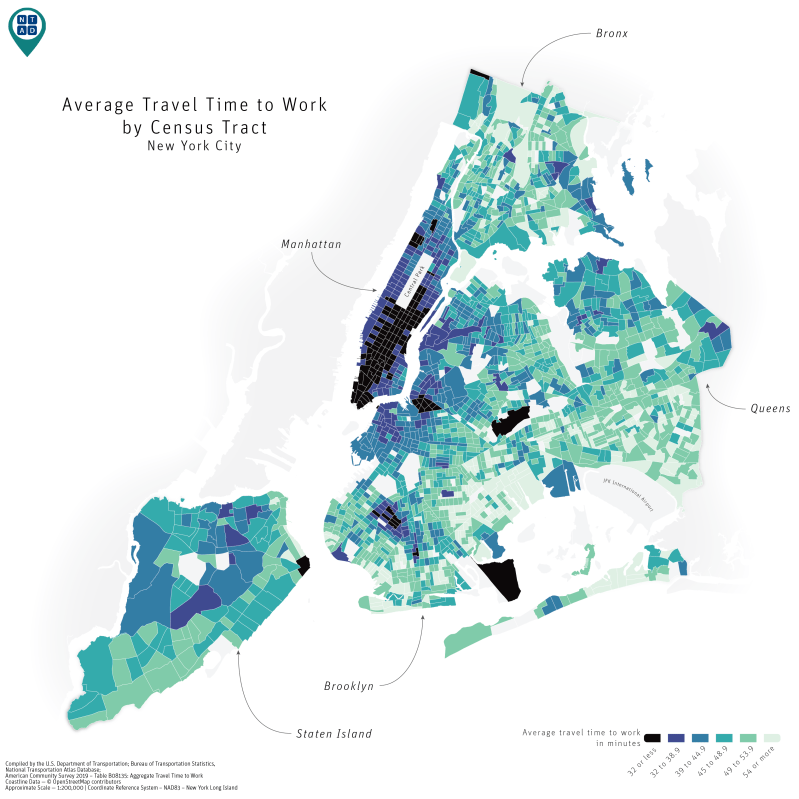Average Commute Time By City – In 2019, more than half (61.3%) of employed people in the EU traveled less than 30 minutes from home to work, i.e. He traveled one-way and without any interruption. In comparison, one in four (26.3%) traveled between 30 and 59 minutes, while less than one in ten (8.1%) employed people traveled 60 minutes or more. Ultimately, only 4.3% of employed people did not have to travel at all to their main place of work. This reflects the situation before the COVID-19 crisis began. With the crisis, the situation will change significantly.
At Member State level, three out of four working people in Greece (75.8%) and Cyprus (75.5%) had a one-way journey of less than 30 minutes. In contrast, only about half of those employed in Luxembourg (49.4%) and Latvia (44.9%) held this position. The latter two countries have the highest share of employed people with travel times of 30–59 minutes among Member States (36.3% and 38.8% respectively). The largest shares of longest commute times were seen in Latvia (13.5%), Ireland (11.2%), Belgium (10.7%) and Hungary (10.6%), where more than 10% of employed people had a commute of 60 minutes or more. Had to travel. From home to work.
Average Commute Time By City
:no_upscale()/cdn.vox-cdn.com/uploads/chorus_asset/file/16189345/boston_car.png?strip=all)
In 2019, the average travel time for employed people in the EU was 25 minutes. The average commute time of employed people was the longest in Latvia (33 minutes), followed by Hungary and Luxembourg (both 29 minutes). Travel times for the largest share of Member States were between 24 and 28 minutes (17 countries). The lowest average commute times were found in Cyprus (19 minutes), Greece (20 minutes), Italy and Portugal (both 21 minutes).
Commute Time Savings When Working From Home
To read more interesting facts and understand background information, please visit the article explaining statistics on main place of work and travel time to work – statistics.
Notes: The European Union (EU) consists of 27 European Union member states. The United Kingdom left the European Union on 31 January 2020. More information is posted here.
If you do not wish to provide a more detailed response, please simply click the “Submit” button to submit your response. Looking at commute times around the world, and especially in the US, we find that most people try to organize their lives so that the average commute time to work is around 30 minutes.
This is the second part of a series on commuting. This section focuses on commuting times. Part one highlights travel distances. The link to this post is: https:///2018/07/commute-times.html
Analyzing Segment’s Commute Time
Regardless of transit mix or availability, the average time for every metro area in the US is very close to 30 minutes. In other countries it is a little longer because more people use public transportation, which is slower than driving.
This also applies to cities, so Chicago, Los Angeles, New York City, and San Francisco have similar average travel times and distributions. The latter two are compared in the chart below (click the chart to enlarge):
There is no point in trying to reduce commute times because people everywhere adjust their lives to keep commute times the same.

Everyone thinks their area has the worst commute times, but in reality, most countries have worse commute times than the US, as seen below (click image to enlarge):
Time Savings When Working From Home
In the above bar chart, the average commute time for all OECD countries (advanced economies) is just under 38 minutes (green bar in the above chart). This is probably because most other countries have better public transportation than the US. In densely populated older cities like Paris and London, which developed before cars became common, public transportation is the only viable way to get to work for many people. Public transport is slower than car transport and increases the average travel time.
We see various differences with the US in the following chart for EU capitals. A large percentage use public transportation, bike, or walk to get to work. In 15 EU cities, 50% or more of people use public transport to get to work. Compare this to the New York City Subway, where about 65% of people travel by car. Only 5% of people in America use public transportation.
In the 17 major EU cities below, more than 25% of people walk to work. In the US overall, only 3% walk to work. The top combined walking/biking rate among US cities is Boston and Washington, DC, at 17%.http://time.com/money/4244782/top-cities-walking-biking-to-work-2016/
Except America, very few developed countries have ever been self-sufficient in oil. Importing oil has a negative impact on their economy. As a result, most European and Asian governments impose high taxes on oil to reduce imports and subsequent foreign exchange losses. With fuel prices hovering around $6 to $7 per gallon, traveling by car in Europe is much more expensive than in the US. High gas taxes subsidize public transportation.
Commuting / Journey To Work
We know from the US Census American Community Survey that the average commute time in the US is 26 minutes. Here are the 20 longest commutes in American cities. Their average is around 30 minutes. California’s cities are “in boxes.” (Click graphic to enlarge).
The specific cities in the earlier commute time charts are a small percentage of their respective metropolitan areas. Now we look at the attention metro areas. I used (mostly) the same 26 large and fast-growing urban areas for commute times that I covered for Commute Distance Part 1 (with very few exceptions). This represents 44 million workers and 100 million residents.
In the SF Bay Area, there is a large variation in commute times by community. The MTC (Metropolitan Transit Commission) has excellent data on each community and the entire Bay Area, as seen in the map below (click images to enlarge):

Why do Sunnyvale workers travel so much more than Sunnyvale residents? Those with more money win the bidding process that determines rents and housing costs. Because Sunnyvale is in the heart of Silicon Valley, home to high-paying tech jobs, tech workers are winning bidding wars to be close to work. Workers who cannot afford to live in Sunnyvale commute to work. Sunnyvale residents may not work in Sunnyvale, but most don’t commute far.
Solved 18. The Average Time That Americans Commute To Work
There is also a certain amount of personal preference involved. Some people simply prefer a less dense hometown “feel” and will travel from more rural areas even if they can afford a place closer to work.
As a long-time user of all forms of public transportation, I can attest to its benefits. This is usually (not always) less stressful than driving. With a set of noise-canceling headphones and a book, time flies. However, it takes more time and there is no way to avoid it.
As seen in the graph below, average and median bus speeds in the US are less than 13 mph and falling. This does not include arrival time, waiting for the bus or any transfers. In the San Jose, CA and San Francisco-Oakland metropolitan areas, buses are slightly slower, averaging 11 and 12 mph, respectively: (click chart to enlarge)
The very long time for public transport (mainly buses) is due to a combination of stopping time for picking up and dropping off passengers, difficulty in reaching the nearest boarding point (access time) and operating large buses. City streets.
Is Treasure Valley Traffic Really That Much Worse Than It Was A Few Years Ago?
This may be one reason why public transportation use is declining in the US, including New York City, as seen in the graph below:
Transport speed is important for access to work. In our study of commute distances in the US, we found that driving alone averaged about 18 miles. See graphic below:
Here we see that the average commute time is around 30 minutes. Traveling 18 miles (average) in 30 minutes (average) means the car’s average travel speed is about 36 miles per hour. Compare this to San Jose’s average bus speed of about 12 mph. If you can go 36 mph in a car, but only 12 mph on a bus, simple geometry says your car gives you 9 times the reach of the job search area . [Due to geometry: Area traveled = (Pi) R(square)]

In reality, however, people drive an average of only 18 miles to work and take a bus about 9 miles away. This still means a huge gap in job opportunities. Consider Los Angeles, as shown below, with a range of 18-mile, 30-minute drives versus 9-mile, 50-minute bus trips. (Click graphic to enlarge).
Cities That Lose The Most Time In Rush Hour Traffic
Someone who drives a car (Great Circle) has access to 4 times more land and probably 4 times more jobs than if they took transit. This is the second reason (the first being time) that most people prefer cars for travel and bus travel is in decline.
If a travel time of about 30 minutes doesn’t sound right for most major US metro areas, you’re not thinking about an average, but about two hours of the morning commute, when all commutes to work It is almost half. , This brings us to the big
Average commute to work, average american commute miles, average commute, average commute time by state, average bike commute, average daily commute, average commute distance, average american commute, average commute time to work, average commute time, average commute time los angeles, average commute time usa


